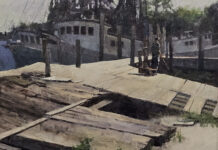
It may be hard to overstate the importance of the plein air experience for Thomas Jefferson Kitts when he decides to take an on-location study up to the size of a large studio piece. The Washington State painter, a featured instructor at the Plein Air Convention & Expo (PACE), looks to his plein air studies for an immense amount of information, from color notes to composition, and he relies on his memory of the experience for verisimilitude and a sense of spontaneity.

“Field study for ‘Beaver Dam off the Columbia River,'” by Thomas Jefferson Kitts, 2013, oil, 8 x 10 in.
“One of the biggest dangers in enlarging in the studio is you lose the spontaneity of the study,” says Kitts. “And for me, the more successful paintings come shortly after the sketch, while it’s fresh in my mind. Otherwise, I may forget the joy of the day in which I painted, and suddenly it becomes more intellectual.”

“Second field study for ‘Beaver Dam off the Columbia River,'” by Thomas Jefferson Kitts, 12 x 16 in. Painted two days later

“Beaver Dam off the Columbia River,” by Thomas Jefferson Kitts, 2013, oil, 20 x 30 in. Studio painting
Kitts pursues a finished piece every time he goes out in the field, and he expects much from them. For a studio piece, he will look to the plein air study for an abundance of information — but Kitts emphasizes that information does not equal detail. “For a larger studio painting to work, there must be something that can survive and be present when the plein air piece is enlarged,” he says. “Maybe the contrast in lights and darks or in colors, a strong representation of light and dark masses, and there’s a strong sense of design or composition. If it is not present in the study, it will not appear in the larger piece. All the things that make a good painting must be present in the study.”

“Field study for ‘Umbrella Creek, Mt. Hood,'” by Thomas Jefferson Kitts, ca. 1995, oil, 6 x 6 in.
At the same time, the smaller plein air piece will not have all the answers. “When you go from small to large, a lot of things happen,” says Kitts. “For example, you can’t just smudge the horizon to blend the sky and land colors. You must mix the color when you are suddenly looking at a scene at 800 percent. And there’s just more real estate, and paint handles very differently on a larger scale. Going up in size on the brushes is helpful, but the way paint breaks on the surface is going to be different than in a small format. And finally, some information will have to be imagined. In a plein air sketch, you can lump the leaves of a tree into one shape. In the studio, you paint some individual leaves. That’s not what you are looking at in the plein air sketch. You are inventing it. There’s nothing wrong with painting from your head for these types of things.”

“Umbrella Creek, Mt. Hood,” by Thomas Jefferson Kitts, ca. 1996, oil, 18 x 48 in. Kitts says his first attempt at painting the scene in the studio based on the study failed, so he painted the larger piece primarily in the field, with finishing touches made in the studio.

“Spring at Steelman Lake” by Thomas Jefferson Kitts, 2010, oil, 12 x 12 in. Plein air
On the other hand, working from a plein air piece has distinct advantages. “You don’t have to work from photos if you have sketches,” Kitts points out. “Photos don’t convey the same color and value relationships that you see with your eyes. A study is a closer record of what you see outside.” The studio also allows an artist to concentrate on various methods of mark-making, resulting in more and varied texture. “You can build up layers, overstrike, and generally use the technique you want,” says Kitts. And most of all, the plein air sketch freezes the plein air experience in time and in two dimensions — the study frees one from chasing the changing light. It sets the color scheme. “Outdoors, everything’s changed in three hours, but not when you studio paint from a sketch,” says Kitts.

“Spring at Steelman Lake,” by Thomas Jefferson Kitts, 2013, oil, 20 x 30 in. Studio painting
Kitts says he used to work fairly large outdoors, and he’s starting to do that again. He notes that some painters on the plein air competition circuit are “putting all their eggs in one basket” with one large painting instead of finishing three small pieces. “It’s impressive,” he remarks. “And with the economy improving, a lot of us have been going up in size. You get to physically move your arms, get your shoulder into it. I miss that.” The Portland artist says he also plans on painting the same piece over several sessions and exploring the fruits of that approach. “Monet worked on a piece for two years, layering, going back outdoors, working on it in the studio,” Kitts says. “Masters like Monet and Courbet didn’t do it all in one shot.”




